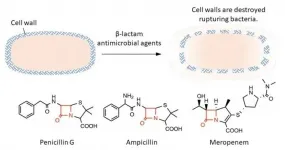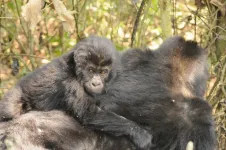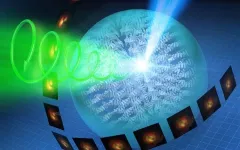A new culprit in antibacterial resistance: cysteine persulfide
2021-06-09
(Press-News.org) A joint research project based in Kumamoto University, Japan has developed a new, highly sensitive analytical method that can detect degraded β-lactam antibacterial agents used in the treatment of bacterial infections. With this method, researchers found that reactive sulfur species produced by bacteria degrade and inactivate β-lactam antibiotics.
Bacteria are different from animal cells in that their outer layer is covered with a rigid structure called a cell wall. β-lactam antimicrobial agents interfere with the processes that form the cell wall. This results in bacteria no longer being able to withstand their own internal pressure so they rupture and die. β-lactam antimicrobial agents are very potent because they selectively inhibit bacterial cell wall synthesis and have few side effects on hosts such as humans. These antimicrobial agents have a common structure called the β-lactam ring that is essential for inhibiting cell wall development. If this ring is degraded, the antimicrobial effect disappears.
Previous studies have reported that hydrogen sulfide (H2S), which bacteria produce during sulfur metabolism, reduces their susceptibility to antimicrobial agents leading to resistance. However, the detailed mechanism causing this are not yet understood. Researchers at Kumamoto University previously showed that the molecule cysteine persulfide, a combination of H2S and the amino acid cysteine, has an extremely potent antioxidant effect that is not found in H2S or cysteine alone.
In this study, researchers examined how this reactive sulfur species is involved in the acquisition of resistance to β-lactam antibiotics. They discovered that β-lactam antibiotics such as penicillin G, ampicillin, and meropenem (carbapenem antibiotics) rapidly lose bactericidal activity when exposed to cysteine persulfide but not with hydrogen sulfide. A detailed study of the reaction between β-lactam antimicrobial agents and cysteine persulfide revealed that the β-lactam ring, which is essential for bactericidal action, decomposes and a sulfur atom is inserted into part of the ring creating carbothioic acid. The production of carbothioic acid from a β-lactam antimicrobial agent appears to be a novel degradation metabolite.
Researchers thus developed a highly sensitive analytical method to detect and quantify carbothioic acid using mass spectrometry, and then analyzed carbothioic acid production from bacteria that were exposed to β-lactam antimicrobials. They found that bacteria can absorb antimicrobial agents and use cysteine persulfide to degrade the agents into carbothioic acid which is then discharged. This is believed to be a previously undescribed inactivation and degradation mechanism of β-lactam antimicrobial agents into carbothioic acid by cysteine persulfide.
"Our newly developed analytical method makes it possible to quantify the amount of carbothioic acid discharged from bacteria with high sensitivity," said Professor Tomohiro Sawa, who led the study. "We believe it will be possible to screen for compounds that inhibit bacterial synthesis of cysteine persulfide by using carbothioic acid as a biomarker. Such a cysteine persulfide synthesis inhibitor in combination with β-lactam antibiotics is expected to inhibit antibiotic degradation and result in successful treatments with a lower concentration of β-lactam antibiotics. This should also help to reduce the emergence of new resistant bacteria."
INFORMATION:
This research was posted online in "ACS Chemical Biology" on 30 March 2021.
Source:
Ono, K., Kitamura, Y., Zhang, T., Tsutsuki, H., Rahman, A., Ihara, T., ... Sawa, T. (2021). Cysteine Hydropersulfide Inactivates β-Lactam Antibiotics with Formation of Ring-Opened Carbothioic S-Acids in Bacteria. ACS Chemical Biology, 16(4), 731-739. doi:10.1021/acschembio.1c00027
[Attachments] See images for this press release:

ELSE PRESS RELEASES FROM THIS DATE:
2021-06-09
For nearly half a century, astrophysicists and organic chemists have been on the hunt for the origins of C6H6, the benzene ring - an elegant, hexagonal molecule comprised of 6 carbon and 6 hydrogen atoms.
Astrophysicists say that the benzene ring could be the fundamental building block of polycylic aromatic hydrocarbons or PAHs, the most basic materials formed from the explosion of dying, carbon-rich stars. That swirling mass of matter would eventually give shape to the earliest forms of carbon - precursors to molecules some scientists say are connected to ...
2021-06-09
New research shows transmission of the virus behind COVID-19 varies seasonally, but warmer conditions are not enough to prevent transmission.
The study, led by Imperial College London researchers and published today in Proceedings of the National Academy of Sciences, is the first to incorporate environmental data into epidemiological models of the transmission of SARS-CoV-2, the virus behind COVID-19.
The team show that temperature and population density are the most important factors determining how easily the virus spreads, but only in the absence of mobility-restricting measures, such as lockdowns.
First author of the study Dr Tom Smith, from the Department of Life Sciences at Imperial, said: "Our results ...
2021-06-09
KINSHASA, Democratic Republic of Congo (June 9, 2021) - A new study led by the Wildlife Conservation Society (WCS) has updated the global population estimate for the Critically Endangered Grauer's gorillas (Gorilla beringei graueri) - the world's largest gorilla subspecies- to 6,800 individuals from a previous global estimate of 3,800 individuals. This revised estimate comes from recent field surveys conducted in one of this animal's largest remaining strongholds, in areas that were previously inaccessible for surveys. However, these gorillas continue to be heavily impacted by ongoing insecurity, and by human incursion into their remaining habitat in eastern Democratic Republic of Congo.
Publishing in the American Journal of Primatology, ...
2021-06-09
Researchers at Vanderbilt University Medical Center (VUMC) have identified a common mechanism underlying a spectrum of epilepsy syndromes and neurodevelopmental disorders, including autism, that are caused by variations in a gene encoding a vital transporter protein in the brain.
Their findings, reported last month in the journal Brain, suggest that boosting transporter function via genetic or pharmacological means could be beneficial in treating brain disorders linked to these genetic variations.
"This points (to) a clear direction of treating a wide spectrum of neurodevelopmental disorders, from various epilepsy syndromes (and) autism to neurodevelopmental delay and intellectual ...
2021-06-09
June 9, 2021 - The first analysis of medical evidence on domestic mass shooters in the U.S. finds that a large majority of perpetrators have psychiatric disorders for which they have received no medication or other treatment, reports a study in the Journal of Clinical Psychopharmacology. The journal is published in the Lippincott portfolio by Wolters Kluwer.
"Without losing sight of the larger perspective that most who are violent are not mentally ill, and most of the mentally ill are not violent, our message is that mental health providers, lawyers, and the public should be made aware that some unmedicated patients do pose an increased risk of violence," according to the report by Ira D. Glick, MD, of Stanford University School of Medicine and colleagues.
In-depth analysis of ...
2021-06-09
Smithsonian Conservation Biology Institute scientists are one step closer to understanding why some corals can weather climate change better than others, and the secret could be in a specific protein that produces a natural sunscreen. As their name implies, Hawaiian blue rice corals sport a deep blue pigment, which is created by chromoprotein and filters out harmful ultraviolet (UV) radiation from the sun. Although UV damage may produce long-term impacts to reproduction in many coral species--including brown rice coral--it may not have the same effect on blue rice coral. The findings of this study were published June 9 in ...
2021-06-09
From 1980 to 2016, grain production in Brazil increased more than fourfold, and the country now stands as the world's largest soybean exporter and the second largest exporter of corn. The two main drivers of this increase in food production were cropland expansion and double-cropping, harvesting two crops, such as corn and soybeans, from the same field in a single year.
While cropland expansion has long been recognized as one of the drivers behind the increase in Brazil's agricultural output, a new study published in Nature Food quantifies for the first time the impact that double-cropping also ...
2021-06-09
The fairy circles of the Namib are one of nature's greatest mysteries. Millions of these circular barren patches extend over vast areas along the margins of the desert in Namibia. In 1979, G.K. Theron published the first research about their origin. His hypothesis was that poisonous substances from Euphorbia damarana leaves induced fairy circles. As part of a new study, scientists from the University of Göttingen and the Gobabeb Namib Research Institute located the original euphorbia plants that were part of Theron's study. Four decades later, the researchers are now able to conclusively disprove Theron's original hypothesis. Their results were published in the journal BMC Ecology and Evolution.
In the late 1970s, South African botanist Theron noticed ...
2021-06-09
A University of Oklahoma doctoral student, graduate and undergraduate research assistants, and an associate professor in the Homer L. Dodge Department of Physics and Astronomy in the University of Oklahoma College of Arts and Sciences are lead authors on a paper describing a "changing-look" blazar - a powerful active galactic nucleus powered by supermassive blackhole at the center of a galaxy. The paper is published in The Astrophysical Journal.
Hora D. Mishra, a Ph.D. student, and faculty member Xinyu Dai are lead authors of the paper, along with Christopher Kochanek and Kris Stanek at the Ohio State University and Ben Shappee at the University of Hawaii. The paper represents the findings of researchers from 12 different institutions who participated ...
2021-06-09
Tsukuba, Japan - Holographic displays help add a three-dimensional--and thus more life-like--feel to what would otherwise appear as a two-dimensional image. Now, researchers in Japan have tested how this may work on a supramolecular level; such tests could lead to improved displays.
Commonly, one cannot overlay a certain type of molecular component that underlies helically arranged liquid crystals onto their molecular mirror images, much like a person cannot overlay their two hands and have them match up exactly without flipping one over. Molecules with this property are described as "chiral." Some materials make use of the principle of chirality to rotate light in a plane perpendicular to the direction of the light wave, known as circular ...
LAST 30 PRESS RELEASES:
[Press-News.org] A new culprit in antibacterial resistance: cysteine persulfide








